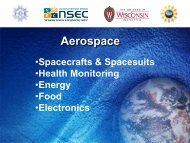presentation here - Institute for Chemical Education
presentation here - Institute for Chemical Education
presentation here - Institute for Chemical Education
Create successful ePaper yourself
Turn your PDF publications into a flip-book with our unique Google optimized e-Paper software.
8/11/2008<br />
Nanotechnology - Gateway<br />
Plat<strong>for</strong>m to Sustainable &<br />
Renewable Energy Applications<br />
Charles Ostman<br />
VP, Chair, Electronics & Photonics Forum – NanoSig<br />
Senior Consultant – Strategic Synergy Group<br />
Senior Fellow - <strong>Institute</strong> <strong>for</strong> Global Futures<br />
510 549 0129 costman@nanosig.org<br />
http://www.technofutures.com/charles1.html
8/11/2008<br />
Energy – the Grand Challenge<br />
―Nanotechnology needs a grand challenge . . . ―<br />
James Von Ehr, Zyvex<br />
Storage<br />
Conversion<br />
Production<br />
Application
Major Nanotechnology Enabled Energy<br />
Applications Related Domains of Interest<br />
Nanostructured materials in reversible hydrogen fuel storage, high<br />
density electrical storage<br />
Mesoporous 3D structural manifolds in catalysis, storage, and<br />
conversion<br />
hybrid materials consisting of inorganic semiconductors and organic<br />
polymers, other variations of organic semiconductors in solar<br />
conversion<br />
Nanocatalysts, membranes, and aerogels in fuel cells<br />
Superconductive and ―ultraconductive‖ nano-materials<br />
Nanocatalysis, nanoparticulates in coal liquifaction<br />
8/11/2008
Example Companies Currently Developing Energy Related<br />
Nanostructured Materials and Fabrication Processes<br />
- partial list<br />
Carbon Nanotechnologies, Inc.<br />
Hyperion Catalysis International<br />
MicroCoating Technologies<br />
NanoPowder Enterprises, Inc.<br />
Superior MicroPowders<br />
Quantum Polymers<br />
MicroCoating Technologies, Inc<br />
Next Generation Energy Corp.<br />
Millenium <strong>Chemical</strong>s<br />
Monsanto Company<br />
Nanopowder Enterprises, Inc.<br />
Aerogel Composite, LLC<br />
Applied Nanotechnologies, Inc<br />
Ntera Ltd<br />
Nanosys<br />
Hydrocarbon Technologies Inc<br />
8/11/2008<br />
Nanomix
Carbon Nanotubes and Nanostructures<br />
PEM (Polymer Electrolyte Membrane / Proton<br />
Exchange Membrane) Fuel Cells<br />
Reversible Hydrogen Storage<br />
Ultra-Capacitors, Batteries<br />
8/11/2008
Current and Future Energy Situation -<br />
8/11/2008<br />
Catalysis Enabled Evolution
8/11/2008<br />
Nanostructured Catalysts<br />
Precise control of size, shape, spatial distribution, surface<br />
composition, and surface interface of atomic structure of the<br />
individual nanocomponents.
8/11/2008<br />
Nanostructured Materials<br />
Foundry processes / fabrication techniques enabling mass<br />
production of nanoparticles<br />
Broad range of functionality
Examples of Nanostructures Enabling<br />
8/11/2008<br />
Energy Conversion<br />
Inorganic energy conversion devices which can be<br />
fabricated to mimic biological processes at the nanoscale<br />
Pore solid 3D architectures enabling continuous molecular<br />
transport <strong>for</strong> energy storage and conversion<br />
Multiple species of aerogels – Silica, Alumina, Carbon,<br />
Organic
8/11/2008<br />
Hydrogen Fuel Cells<br />
A fuel cell consists of two electrodes—a negative<br />
electrode (or anode) and a positive electrode (or<br />
cathode)—sandwiched around an electrolyte.<br />
Hydrogen is fed to the anode, and oxygen is fed to<br />
the cathode. Activated by a catalyst, hydrogen atoms<br />
separate into protons and electrons, which take<br />
different paths to the cathode. The electrons go<br />
through an external circuit, creating a flow of<br />
electricity. The protons migrate through the<br />
electrolyte to the cathode, w<strong>here</strong> they reunite with<br />
oxygen and the electrons to produce water and heat
Examples of Hydrogen Fuel Cell Types<br />
Proton-Exchange Membrane Fuel Cells<br />
Phosphoric Acid Fuel Cells<br />
Solid Oxide Fuel Cells<br />
Molten Carbonate Fuel Cells<br />
Regenerative or Reversible Fuel Cells<br />
Alkaline Fuel Cells<br />
8/11/2008
8/11/2008<br />
NanoElectronic Photovoltaic Circuitry<br />
Printed on Paper, Cloth, Plastics
8/11/2008<br />
Fundamental Questions<br />
Does electricity necessarily need to be ―on the grid‖ <strong>for</strong> all<br />
uses?<br />
Does fuel <strong>for</strong> transportation necessarily have to come from<br />
refined biomass?
8/11/2008<br />
Define ―Alternative‖ Fuel . . .<br />
Production of ethanol as an alternative fuel source,<br />
derived from corn as an example, requires more<br />
energy to grow and refine, than the actual fuel<br />
energy yield
Hydrogen – Purported Arguments Against<br />
Requires enormous investments in electrical energy, such as<br />
from nuclear power plants, to create the hydrogen<br />
Dangerous, difficult to store and retrieve<br />
Disruptive to an already existing petroleum / ethanol fuel<br />
production infrastructure<br />
8/11/2008<br />
Hydrogen Fuel Cells in
8/11/2008<br />
Nanotechnology in<br />
Hydrogen Energy Development<br />
Storage<br />
Hydrogen<br />
Energy<br />
Conversion Production
8/11/2008<br />
Hydrogen – A Second Look –<br />
What if . . .<br />
Nanostructured materials, such as carbon nanotubes, and other<br />
mesoporous materials being developed <strong>for</strong> reversible storage<br />
Hydrogen production can become a new industrial infrastructure<br />
Modification to existing transportation vehicles relatively minor<br />
Wind generated electrical energy to create the hydrogen –<br />
nanostructured materials, as in lubricants and composite materials,<br />
can be applied to improved wind turbine per<strong>for</strong>mance, MTBF<br />
Hydrogen fueling dispenser<br />
at the Las Vegas Energy<br />
Station - Air Products and<br />
<strong>Chemical</strong>s, Inc.
Wind Energy Projects<br />
Throughout the United States of America<br />
TOTAL INSTALLED WIND ENERGY CAPACITY:<br />
4,329 MW as of 09/30/02<br />
8/11/2008
DOE - National Hydrogen Energy Roadmap<br />
Workshop Event Wash DC April 2-3 2002<br />
A product recognition tag, similar to<br />
EnergyStar ® , should be developed, and<br />
hydrogen success stories should be touted.<br />
Other public relations and outreach activities<br />
would include:<br />
.Construction of traveling exhibits on hydrogen<br />
.Expansion of online hydrogen databases and<br />
in<strong>for</strong>mation center<br />
.Creation of compact disks and Internet marketing<br />
materials<br />
Hydrogen needs to be ―branded‖ and ―personalized‖ <strong>for</strong> the consumer; safety needs to be<br />
stressed. Messages need to be consistent (e.g., ―Hydrogen is the Freedom Fuel,‖ ―Hydrogen—It<br />
Works,‖ or ―Hydrogen is ‗The Power‘‖).<br />
In addition, industry should work with filmmakers to include product placement in movies.<br />
Community models and exhibits should also be developed to promote consumer participation and<br />
action.<br />
8/11/2008
http://www.awea.org/<br />
8/11/2008<br />
Example Web Resources<br />
http://www.eren.doe.gov/wind/links.html<br />
http://www.nrel.gov/wind/<br />
http://www.eren.doe.gov/RE/hydrogen.html<br />
http://www.eren.doe.gov/RE/hydrogen_fuel_cells.html<br />
http://www.fuelcells.org/sitemap.htm
Nanotechnology Enabled Defense Development Domains<br />
Potentially Re-purposed Toward Energy Applications<br />
Extreme high density energy storage and discharge systems<br />
―Smart‖ membranes, molecularly selective filters<br />
Aerogels, nanocrystals, composite nanostrcutured materials<br />
8/11/2008
The New ―Mission Critical‖ Imperative<br />
When JFK declared we would have men on the<br />
moon in a decade, many thought this was<br />
impossible. Today the mission could be<br />
energy independence in 10 years.<br />
Ten years of development time now is very<br />
different than ten years of development time<br />
four decades ago.<br />
8/11/2008
The New ―Mission Critical‖ Imperative –<br />
8/11/2008<br />
Concluding Statement<br />
Cheap, clean, sustainable, universally available energy in abundance -- is the single<br />
most important technical problem facing the world in the 21 st century.<br />
If we solve this energy problem we can help solve most of the other top problems<br />
we face in this century: water, food, pollution, greenhouse gases, poverty in the<br />
developing nations and the over-population and lack of education that make them<br />
such potent breeding grounds <strong>for</strong> religious fanaticism, terrorism, and war.<br />
Conversely, if we don‘t solve the energy problem, t<strong>here</strong> may not be an acceptable<br />
answer to any of these other problems.<br />
- Richard Smalley













